Southampton: Difference between revisions
mNo edit summary |
|||
| (2 intermediate revisions by 2 users not shown) | |||
| Line 105: | Line 105: | ||
|title=Great Sites: Hamwic | |title=Great Sites: Hamwic | ||
|quote=Hamwic, which is described as a commercial port (''mercimonium''). Hamwic (also known as Hamtun) must have possessed considerable administrative importance as by the middle of the 8th century it had given its name to the shire - Hamtunscire. | |quote=Hamwic, which is described as a commercial port (''mercimonium''). Hamwic (also known as Hamtun) must have possessed considerable administrative importance as by the middle of the 8th century it had given its name to the shire - Hamtunscire. | ||
}}</ref> Archaeological excavations of this site have uncovered one of the best collections of Saxon artifacts in Europe.<ref name=MusArch/> It is from this town that the county | }}</ref> Archaeological excavations of this site have uncovered one of the best collections of Saxon artifacts in Europe.<ref name=MusArch/> It is from this town that the county gets its name. | ||
Viking raids from 840 onwards contributed to the decline of Hamwic in the 9th century,<ref>{{cite web |url=http://www.southampton.gov.uk/s-leisure/artsheritage/museums-galleries/ghtower-museumofarchaeology/saxon.aspx | Viking raids from 840 onwards contributed to the decline of Hamwic in the 9th century,<ref>{{cite web |url=http://www.southampton.gov.uk/s-leisure/artsheritage/museums-galleries/ghtower-museumofarchaeology/saxon.aspx | ||
| Line 357: | Line 357: | ||
[[Category:Ports of Hampshire]] [[Category:Major ports in the United Kingdom]] | [[Category:Ports of Hampshire]] [[Category:Major ports in the United Kingdom]] | ||
{{Catself}} | |||
{{Cities in the United Kingdom}} | |||
Latest revision as of 14:22, 30 March 2016
| Southampton | |
| Hampshire | |
|---|---|
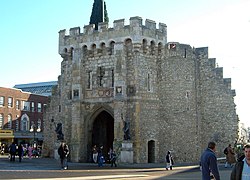 The Bargate, Southampton | |
| Location | |
| Grid reference: | SU420114 |
| Location: | 50°54’4"N, 1°24’14"W |
| Data | |
| Population: | 234,600 (est.) |
| Post town: | Southampton |
| Postcode: | SO14-SO19 |
| Dialling code: | 023 |
| Local Government | |
| Council: | Southampton |
Southampton is the largest city in Hampshire and the busiest commercial port in the United Kingdom, indeed one of the largest commercial ports in Europe.
The city stands at the northernmost point of Southampton Water at the meeting of the River Test and River Itchen. Southampton Water provides a deep, broad, sheltered English Channel roadstead, which has ensured Southampton's foremost place among the Channel ports.
The city represents the core of the "Greater Southampton" region, and the city itself has an estimated population of 234,600 (mid-year est., 2008).[1] The city's name is sometimes abbreviated in writing to "So'ton" or "Soton", from which its citizens are known as "Sotonians". Southampton is noted for its association with the Titanic,[2] the Spitfire[3] and more recently a number of the largest cruise ships in the world.[4][5]
Geography
The geography of Southampton is influenced by the sea and rivers. The city lies at the northern tip of the Southampton Water, a deep water estuary, which is a ria formed at the end of the last Ice Age. Here, the rivers Test and Itchen converge.[6] The Test—which has salt marsh that makes it ideal for salmon fishing[7]—runs along the western edge of the city, while the Itchen splits Southampton in two—east and west. The city centre is located on the peninsula between the two rivers.
Much of the waterfront has been reclaimed over the years, mainly for use as the Western Docks.[8] Most of the land used for reclamation came from dredging of Southampton Water,[9] to ensure that the port can continue to handle large ships.
Southampton Water has the benefit of a double high tide, with two high tide peaks,[10] making the movement of large ships easier.[11] This double tide affects much of the Channel coast and while the flow around the Isle of Wight may have some effect, it appears to be more to do with the overall geography of the English Channel. [12]
The city lies in the Hampshire Basin, which sits atop chalk beds.[6]
The River Test runs along the western border of the city, separating it from the New Forest. There are bridges over the Test from Southampton, including the road and rail bridges at Redbridge in the south and the M27 motorway to the north. The River Itchen runs through the middle of the city and is bridged in several places. The northernmost bridge, and the first to be built,[13] is at Mansbridge, where the A27 road crosses the Itchen. The original bridge is closed to road traffic, but is still standing and open to pedestrians and cyclists. The river is bridged again at Swaythling, where Woodmill Bridge separates the tidal and non tidal sections of the river. Further south is Cobden Bridge which is notable as it was opened as a free bridge (it was originally named the Cobden Free Bridge), and was never a toll bridge. Downstream of the Cobden Bridge is the Northam Railway Bridge, then the Northam Road Bridge, which was the first major pre-stressed concrete bridge to be constructed in the United Kingdom.[14] The lowest bridge on the Itchen is the Itchen Bridge, which is a toll bridge.
History
Archaeological finds suggest that the area has been inhabited since the stone age.[15] According to the Chronicle of the Britons the Ancient Britons had called the place Porth Hamon after a certain Lelius Hamo, a traitor who had murdered king Togodumnus during the early stages of the Roman invasion of Britain.[16] Following the Roman invasion of Britain in AD 43 and the conquering of the local Britons in 70 AD the fortress settlement of Clausentum was established. It was an important trading port and defensive outpost of Winchester, at the site of modern Bitterne Manor. Clausentum was defended by a wall and two ditches and is thought to have contained a bath house.[17] Clausentum was not abandoned until around 410.[15]
Foundation
The Gewissae Saxons formed a new, larger, settlement across the River Itchen centred on what is now the St Mary's area of the city. The settlement was known as Hamwic,[15] which evolved into Hamtun and then Hampton.[18] Archaeological excavations of this site have uncovered one of the best collections of Saxon artifacts in Europe.[15] It is from this town that the county gets its name.
Viking raids from 840 onwards contributed to the decline of Hamwic in the 9th century,[19] and by the 10th century a fortified settlement, which became mediaeval Southampton had been established.[20] In 1016 Cnut of Denmark came to Southampton, where part of the Witenagemot, the "parliament" of nobles and clergy, declared him King of the English, while the rest of the Witan, in London chose Edmund Ironside.
The Middle Ages
Following the Norman Conquest in 1066, Southampton became the major port of transit between the then capital of England, Winchester, and Normandy. Southampton Castle was built in the 12th century[21] and by the 13th century Southampton had become a leading port, particularly involved in the import of French wine[20] in exchange for English cloth and wool.[22]
Surviving remains of 12th century merchants' houses such as King John's House and Canute's Palace are evidence of the wealth that existed in the town at this time.[23] In 1348, the Black Death reached England via merchant vessels calling at Southampton.[24]
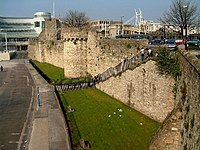
The town was sacked in 1338 by French, Genoese and Monegasque ships (under Charles Grimaldi, who used the plunder to help found the principality of Monaco).[25] On visiting Southampton in 1339, Edward III ordered that walls be built to 'close the town'. The extensive rebuilding—part of the walls dates from 1175—culminated in the completion of the western walls in 1380.[26][27] Roughly half of the walls, 13 of the original towers, and six gates survive.[26]
The city walls include God's House Tower, built in 1417, the first purpose-built artillery fortification in England.[28] Over the years it has been used as home to the city's gunner, the Town Gaol and even as storage for the Southampton Harbour Board.[27] Today, it is open as the Museum of Archaeology. The walls were completed in the 15th century,[29] but later development of several new fortifications along Southampton Water and the Solent by Henry VIII meant that Southampton was no longer dependent upon its fortifications.[30]
On the other hand, many of the mediaeval buildings once situated within the town walls are now in ruins or have disappeared altogether. From successive incarnations of the motte and bailey castle, only a section of the bailey wall remains today, lying just off Castle Way.[31] The last remains of the Franciscan friary in Southampton, founded in 1233 and dissolved in 1538, were swept away in the 1940s.[32] The site is now occupied by Friary House.
Elsewhere, remnants of the mediaeval water supply system devised by the friars can still be seen today. Constructed in 1290, the system carried water from Conduit Head (remnants of which survive near Hill Lane, Shirley) a mile to the site of the friary inside the town walls. The friars granted use of the water to the town in 1310 and passed on ownership of the water supply system itself in 1420.[33] Further remains can be observed at Conduit House on Commercial Road.
During the Middle Ages, shipbuilding became an important industry for the town. Henry V's famous warship Grace Dieu was built in Southampton.[21] Walter Taylor's 18th century mechanisation of the block-making process was a significant step in the Industrial Revolution.[34] From 1904 to 2004, the Thornycroft shipbuilding yard was a major employer in Southampton,[21] building and repairing ships used in the two World Wars.[21]
In 1415, before King Henry's departure for France (the campaign culminating in the Battle of Agincourt), the ringleaders of the "Southampton Plot"—Richard, Earl of Cambridge, Henry Scrope, 3rd Baron Scrope of Masham and Sir Thomas Grey of Heton—were accused of high treason and tried at what is now the Red Lion public house in the High Street.[35] They were found guilty and summarily executed outside the Bargate.[36]
Southampton has been used for military embarkation, including during 18th century wars with the French,[37] the Crimean War,[38] and the Boer War.[39] Southampton was designated No. 1 Military Embarkation port during the Great War[21] and became a major centre for treating the returning wounded and POWs.[21] It was also central to the preparations for the Invasion of Europe in 1944.[21]
The modern Period
In 1642, during the English Civil War, a Parliamentary garrison moved into Southampton.[40] The Royalists advanced as far as Redbridge in March 1644 but were prevented from taking the town.[40]
Southampton became a spa town in 1740.[41] It had also become a popular site for sea bathing by the 1760s, despite the lack of a good quality beach.[41] Innovative buildings specifically for this purpose were built at West Quay, with baths that were filled and emptied by the flow of the tide.[41]
The town experienced major expansion during the Victorian era.[21] The Southampton Docks company had been formed in 1835.[21] In October 1838 the foundation stone of the docks was laid[21] and the first dock opened in 1842.[21] The structural and economic development of docks continued for the next few decades.[21] The railway link to London was fully opened in May 1840.[21] Southampton subsequently became known as The Gateway to the Empire.[42]
In 1912, the Titanic sailed from Southampton. Four in five of the crew on board the vessel were Sotonians,[43] with about a third of those who perished in the tragedy hailing from the city.[26] Southampton was subsequently the home port for the transatlantic passenger services operated by Cunard with their Blue Riband liner Queen Mary and her running mate Queen Elizabeth. In 1938, Southampton docks also became home to the flying boats of Imperial Airways.[21] Southampton Container Terminals first opened in 1968[21] and has continued to expand.

The Supermarine Spitfire was designed and developed in Southampton, evolving from the Schneider trophy-winning seaplanes of the 1920s and 1930s. Its designer, R J Mitchell, lived in the Portswood area of Southampton, and his house is today marked with a blue plaque.[44] Heavy bombing of the factory in September 1940 destroyed it as well as homes in the vicinity, killing civilians and workers. Second World War hit Southampton particularly hard because of its strategic importance as a major commercial port and industrial area. Prior to the Invasion of Europe, components for Mulberry Harbour were built here.[21] After D-Day, Southampton docks handled military cargo to help keep the Allied forces supplied,[21] making it a key target of Luftwaffe bombing raids until late 1944.[45]
630 people lost their lives as a result of the air raids on Southampton and nearly 2,000 more were injured, not to mention the thousands of buildings damaged or destroyed.[46]
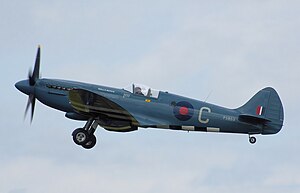
Pockets of Georgian architecture survived the war, but much of the city was levelled. There has been extensive redevelopment since Second World War.[21] Increasing traffic congestion in the 1920s led to partial demolition of mediaeval walls around the Bargate in 1932 and 1938.[21] However a large portion of those walls remain.
A Royal Charter in 1952[21] upgraded University College at Highfield to the University of Southampton.[21] Southampton acquired city status, becoming the City of Southampton in 1964.[21]
Economy
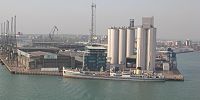
Southampton is a major city and the primary economic centre for Hampshire and the south coast to either side. Jobs in Southampton do not all look to the sea. Just over a quarter of the jobs available in the city are in the health and education sector. A further 19% work in property and other business and the third largest sector is wholesale and retail, which accounts for 16.2%.
Southampton has always been a maritime centre, and the docks have long been a major employer in the city. In particular, it is a port for cruise ships; its heyday was the first half of the 20th century, and in particular the inter-war years, when it handled almost half the passenger traffic of the United Kingdom. Today it remains home to luxury cruise ships, as well as being the largest freight port on the Channel coast and fourth largest united Kingdom port by tonnage:[47] it has several container terminals. Unlike some other ports, such as Liverpool, London, and Bristol, where industry and docks have largely moved out of the city centres leaving room for redevelopment, Southampton retains much of its inner-city industry. Part of the docks has been redeveloped and the Ocean Village development—a local marina and entertainment complex—built. Southampton is home to the headquarters of both the Maritime and Coastguard Agency and the Marine Accident Investigation Branch of the Department for Transport.
During the latter half of the 20th century, a more diverse range of industry also came to the city, including aircraft and car manufacture, cables, electrical engineering, and petrochemicals. These now exist alongside the city's older industries of the docks, grain milling, and tobacco processing.
Southampton University Hospitals NHS Trust is one of the city's largest employers. It provides local hospital services to 500,000 people in the Southampton area and specialist regional services to more than 3 million people across the South of England. The Trust owns and manages Southampton General Hospital, the Princess Anne Hospital and a palliative care service at Countess Mountbatten House.
Other major employers in the city include Ordnance Survey, the United Kingdom's national mapping agency, whose headquarters is in the city. The Lloyd's Register Group has announced plans to move its London marine operations to a specially developed site at the University of Southampton.[48] The area of Swaythling is home to Ford's Southampton Assembly Plant, where the majority of their Transit models are manufactured.

Southampton's largest retail centre is the WestQuay Shopping Centre, opened in September 2000: it is one of the largest in the country.
Other major shopping areas in the city centre include The Mall Marlands, the Bargate Centre and the East Street area, which has been designated for speciality shopping, with the aim of promoting smaller retailers. In 2007, Southampton was ranked 13th for shopping in the United Kingdom.[49]
Southampton's strong economy is promoting redevelopment, and major projects are proposed, including the city's first skyscrapers on the waterfront. The three towers proposed will stand 23 storeys high and will be surrounded by smaller apartment blocks, office blocks and shops. There are also plans for a 15-storey hotel at the Ocean Village marina,[50] and a 21-storey hotel on the north eastern corner of the city centre, as part of a £100m development.[51]
Southampton is the only city in the United Kingdom with a geothermal power station. The station provides hot water to a city centre district heating scheme. In a recent survey of carbon emissions in major UK cities conducted by British Gas, Southampton was ranked as being one of the lowest carbon emitting cities in the United Kingdom.[52]
Culture, media and sport
Culture
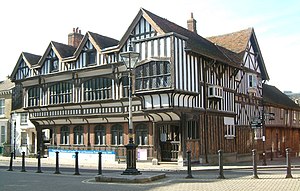
The city has the longest surviving stretch of mediaeval walls in Britain,[53] as well as a number of museums such as Tudor House, Southampton Maritime Museum[54] and Solent Sky, which focuses on aviation.[55] The Titanic Memorial Museum is due to open in 2012 — the 100th anniversary year of the sinking of the Titanic on her maiden voyage.
The annual Southampton Boat Show is held in September each year, with over 600 exhibitors present.[56] It runs for just over a week at Mayflower Park on the city's waterfront, where it has been held since 1968.[57] The Boat Show itself is the climax of Sea City, which runs from April to September each year to celebrate Southampton's links with the sea.[58]
In July 2007, the Daily Echo quoted a survey which described Southampton one of the best places to live in the United Kingdom for single people aged 18 to 30. This was owing to its "low cost of living, wide array of bars and clubs and cheap transport". Women voted it second best behind London, while men rated it as seventh.[59]
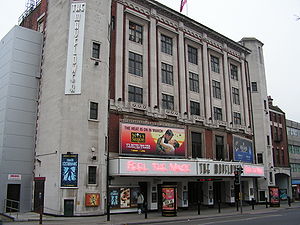
The largest theatre in the city is the 2,300 capacity Mayflower Theatre, which has hosted West End shows and regular visits from Welsh National Opera and English National Ballet. The Nuffield Theatre[60] is based at the University of Southampton's Highfield campus and provides a venue for the Nuffield Theatre Company, touring companies, and local performing societies such as Southampton Operatic Society, The Maskers and The University Players.
Classical and contemporary music
Southampton has two large live music venues, the Mayflower Theatre (formerly the Gaumont Theatre) and the Guildhall. The Guildhall has seen concerts from a wide range of popular artists. It also hosts classical concerts presented by the Bournemouth Symphony Orchestra,[61] City of Southampton Orchestra,[62] Southampton Concert Orchestra,[63] Southampton Philharmonic Choir[64] and Southampton Choral Society.[65]
The city also has several smaller music venues, including The Brook, as well as smaller "club circuit" venues like Hamptons and Lennons, and a number of public houses which host music.
Cruise shipping
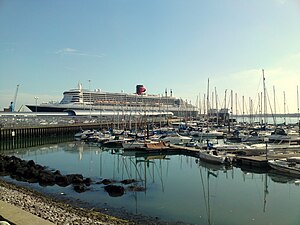
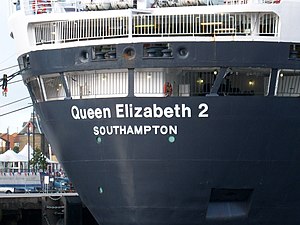
The city is deeply connected to the Cunard Line and their fleet of ships, which are the only passenger vessels to be registered here (thus bearing "Southampton" on the stern). The people of Southampton showed their strong connection with Cunard on 11 November 2008 when the Cunard Liner Queen Elizabeth 2 weighed anchor from the city for the final time amid a spectacular fireworks display after a full day of celebrations.[66]
Proudly continuing the tradition of luxury cruising that began in 1840, Queen Victoria was successfully launched in December 2007 and was named by HRH The Duchess of Cornwall in a spectacular ceremony in Southampton.
In the spring of 2009, a fourth Cruise Terminal was opened in Southampton and Carnival Corporation & plc moved the headquarters of Carnival UK to Southampton.[67][68]
Many of the world's largest cruise ships (including record-breaking vessels operated by P & O, Cunard's sister company based in the United Kingdom, and Royal Caribbean and Cunard) ships as well can regularly be seen in Southampton Water
Transport
Southampton is a major British port which has good transport links with the rest of the country. The M27 motorway, linking places along the south coast of England, runs just to the north of the city. The M3 motorway links the city to London and also, by way of a link to the A34 road at Winchester, with the Midlands and North. The M271 motorway is a spur of the M27, linking it with the Western Docks and city centre.
Southampton is also served by the rail network, which is used both by freight services to and from the docks and passenger services as part of the national rail system. The main station in the city is Southampton Central. Rail routes run east towards Portsmouth, north to Winchester, the Midlands and London, and westwards to Bournemouth, Salisbury, Bristol and Cardiff.
Local train services operate in the central, southern and eastern sections of the city, with several station stations in those neighbourhoods.
Southampton Coach Station, which is located near the West Quay Shopping Centre.
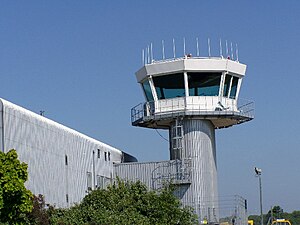
Southampton Airport is a regional airport located in the town of Eastleigh, just north of the city. It offers flights to British and near-European destinations, and is connected to the city by a frequent rail service from Southampton Airport (Parkway) railway station, and by bus services.
While Southampton is no longer the base for any cross-channel ferries, it is the terminus for three internal ferry services, all of which operate from terminals at Town Quay. Two of these, a car ferry service and a fast catamaran passenger ferry service, provide links to East Cowes and Cowes respectively on the Isle of Wight and are operated by Red Funnel. The third ferry is the Hythe Ferry, providing a passenger service to Hythe on the other side of Southampton Water.
Southampton used to be home to a number of ferry services to the continent, with destinations such as San Sebastian, Lisbon, Tangier and Casablanca. A ferry port was built during the 1960s.[69] However a number of these relocated to Portsmouth and by 1996, there were no longer any car ferries operating from Southampton with the exception of services to the Isle of Wight. The land used for Southampton Ferry Port was sold off and a retail and housing development was built on the site. The Princess Alexandra Dock was converted into a marina. New car reception areas now fill the Eastern Docks where passengers, dry docks and trains used to be.
Outside links
- Southampton skyline webcam
- Southampton.co.uk Supporting Local Life Online
- Southampton City Council and CityWeb
References
- ↑ Southampton City Council. "City Statistics and Research". http://www.southampton.gov.uk/living/statsresearch/. Retrieved 19 October 2009.
- ↑ Southampton City Council. "Titanic - A Southampton Story". http://www.southampton.gov.uk/s-leisure/artsheritage/history/titanic/soton-story/. Retrieved 19 October 2009.
- ↑ Solent Sky Museum. "Home of the Spitfire". http://www.spitfireonline.co.uk/. Retrieved 30 July 2007.
- ↑ Visit Southampton. "Southampton - Cruise Capital of Northern Europe". http://www.visit-southampton.co.uk/site/cruise-passenger-and-crew-information. Retrieved 30 July 2007.
- ↑ BBC Online (8 June 2007). "Solent Ship Spotting". http://www.bbc.co.uk/hampshire/content/articles/2006/03/07/shipspotting_feature.shtml. Retrieved 19 October 2009.
- ↑ 6.0 6.1 The Port of Southampton L. E. Tavener Economic Geography, Vol. 26, No. 4 (Oct., 1950), pp. 260–73
- ↑ Environment Agency. "The River Test". http://www.environment-agency.gov.uk/commondata/acrobat/river_test__627604pdf. Retrieved 28 July 2007.
- ↑ The Solent Forum. "Western Solent and Southampton Water Shoreline Management Plan". http://www.solentforum.hants.org.uk/othercoast/western_solent_smp.htm#test6. Retrieved 28 July 2007.
- ↑ eGovernment Monitor (8 July 2005). "Web Maps Out The Past". http://www.egovmonitor.com/node/1811. Retrieved 28 July 2007.
- ↑ Proudman Oceanographic Laboratory. "Tides". http://www.pol.ac.uk/home/insight/tidefaq.html. Retrieved 28 July 2007.
- ↑ Associated British Ports. "Southampton VTS - ABP Southampton". http://www.southamptonvts.co.uk/. Retrieved 28 July 2007.
- ↑ Captain M J Ridge, FRICS MCIT. "English Channel double tides". http://www.bristolnomads.org.uk/stuff/double_tides.htm. Retrieved 16 May 2011.
- ↑ Holt, John; Anne Cole (February 1992). A bend in the River. Southampton: Bitterne Local History Society.
- ↑ "History of Concrete Bridges". www.cbdg.org.uk. http://www.cbdg.org.uk/bridge_history.html. Retrieved 11 March 2008.
- ↑ 15.0 15.1 15.2 15.3 Southampton Museum of Archeology. God's House Tower, Southampton.
- ↑ Wm R Cooper (2002). "The Chronicle of the Early Britons" (PDF). http://www.annomundi.com/history/chronicle_of_the_early_britons.pdf. Retrieved 19 October 2009.
- ↑ Southampton Through the Ages: A Short History by Elsie M. Sandell (revised 1980)
- ↑ British Archaeology Magazine (August 2002). "Great Sites: Hamwic". http://www.britarch.ac.uk/ba/ba66/feat3.shtml. Retrieved 19 October 2009. "Hamwic, which is described as a commercial port (mercimonium). Hamwic (also known as Hamtun) must have possessed considerable administrative importance as by the middle of the 8th century it had given its name to the shire - Hamtunscire."
- ↑ Southampton City Council. "Saxon Southampton". http://www.southampton.gov.uk/s-leisure/artsheritage/museums-galleries/ghtower-museumofarchaeology/saxon.aspx. Retrieved 19 October 2009.
- ↑ 20.0 20.1 Southampton City Council. "Mediaeval Southampton". http://www.southampton.gov.uk/s-leisure/artsheritage/museums-galleries/ghtower-museumofarchaeology/mediaeval.aspx. Retrieved 19 October 2009.
- ↑ 21.00 21.01 21.02 21.03 21.04 21.05 21.06 21.07 21.08 21.09 21.10 21.11 21.12 21.13 21.14 21.15 21.16 21.17 21.18 21.19 21.20 21.21 Rance, Adrian (1986). Southampton. An Illustrated History.. ISBN 0-903852-95-0.
- ↑ British Archaeology Magazine (August 2002). "Great Sites: Hamwic". http://www.britarch.ac.uk/ba/ba66/feat3.shtml. Retrieved 19 October 2009. "The economic motor driving trade [was] larger-scale trade in relatively low value commodities such as wool, timber and quernstones."
- ↑ Rance, Adrian (1986). Southampton. An Illustrated History.. p. 34. ISBN 0-903852-95-0.
- ↑ Rance, Adrian (1986). Southampton. An Illustrated History.. p. 45. ISBN 0-903852-95-0.
- ↑ Internet Archive. "Monaco and Monte Carlo". http://www.archive.org/stream/monacomontecarlo00smit/monacomontecarlo00smit_djvu.txt. Retrieved 19 October 2009.
- ↑ 26.0 26.1 26.2 BBC Online. "Southampton Town Walls and Castle". http://www.bbc.co.uk/dna/h2g2/alabaster/A337141. Retrieved 19 October 2009.
- ↑ 27.0 27.1 Southampton City Council. "God's House Tower: A History of the Museum". http://www.southampton.gov.uk/s-leisure/artsheritage/museums-galleries/ghtower-museumofarchaeology/history.aspx. Retrieved 19 October 2009.
- ↑ Culture24. "God's House Tower Museum of Archaeology, Southampton". http://www.culture24.org.uk/se000276. Retrieved 19 October 2009.
- ↑ Southampton City Council. "Mediaeval Southampton". http://www.southampton.gov.uk/s-leisure/artsheritage/museums-galleries/ghtower-museumofarchaeology/mediaeval.aspx. Retrieved 19 October 2009.
- ↑ Rance, Adrian (1986). Southampton. An Illustrated History.. p. 59. ISBN 0-903852-95-0.
- ↑ Percy G. Stone, A Vanished Castle, Papers & Proceedings of the Hampshire Field Club & Archaeological Society, 12:3 (1934), pp. 241–70
- ↑ Alwyn A. Ruddock, The Greyfriars in Southampton, Papers & Proceedings of the Hampshire Field Club & Archaeological Society, 16:2 (1946), pp. 137–47
- ↑ Rev J Silvester Davies, A History of Southampton Partly From the Ms. Of Dr Speed In The Southampton Archives, 1883, pp. 114–19
- ↑ Rance, Adrian (1986). Southampton. An Illustrated History.. pp. 95–97. ISBN 0-903852-95-0.
- ↑ Southern Daily Echo (2 April 2008). "Red Lion Plot". http://www.dailyecho.co.uk/news/features/hants_facts/2165774.Red_Lion_plot/. Retrieved 19 October 2009.
- ↑ Rance, Adrian (1986). Southampton. An Illustrated History.. p. 48. ISBN 0-903852-95-0.
- ↑ Rance, Adrian (1986). Southampton. An Illustrated History.. p. 92. ISBN 0-903852-95-0.
- ↑ Rance, Adrian (1986). Southampton. An Illustrated History.. p. 120. ISBN 0-903852-95-0.
- ↑ Rance, Adrian (1986). Southampton. An Illustrated History.. p. 138. ISBN 0-903852-95-0.
- ↑ 40.0 40.1 Rance, Adrian (1986). Southampton. An Illustrated History.. pp. 71–72. ISBN 0-903852-95-0.
- ↑ 41.0 41.1 41.2 Rance, Adrian (1986). Southampton. An Illustrated History.. pp. 78–79. ISBN 0-903852-95-0.
- ↑ Southampton City Council. "Post-Mediaeval Southampton". http://www.southampton.gov.uk/s-leisure/artsheritage/museums-galleries/ghtower-museumofarchaeology/postmediaevalsouthampton.aspx. Retrieved 19 October 2009.
- ↑ Titanic-Titanic.com. "Southampton". http://www.titanic-titanic.com/southampton.shtml. Retrieved 19 October 2009.
- ↑ A History of Portswood, 2003, Book, P.Wilson
- ↑ Rance, Adrian (1986). Southampton. An Illustrated History.. p. 169. ISBN 0-903852-95-0.
- ↑ Plimsoll – The Southampton Blitz
- ↑ (DFT) Provisional Port Statistics 2007
- ↑ Lloyd's Register (21 April 2006). "Lloyd's Register announces plans to move Marine operations to Southampton". http://www.lr.org/Industries/Marine/News/1706+Southampton.htm. Retrieved 19 October 2009.
- ↑ Southampton City Council. "4. An International City of Culture" (PDF). http://www.southampton.gov.uk/Images/City%20of%20Culture%20pages%2013-24_tcm46-220390.pdf. Retrieved 19 October 2009.
- ↑ Southern Daily Echo (25 May 2006). "Grand Designs for New Hotel". http://www.dailyecho.co.uk/search/display.var.772549.0.grand_designs_for_new_hotel.php. Retrieved 19 October 2009.
- ↑ Southern Daily Echo (22 May 2007). "Four Star Hotel for City Centre?". http://www.dailyecho.co.uk/search/display.var.1416419.0.fourstar_hotel_for_city_centre.php. Retrieved 19 October 2009.
- ↑ British Gas News (22 May 2006). "Reading named as the United Kingdom's highest CO2 hot spot". http://www.britishgasnews.co.uk/index.asp?PageID=16&Year=2006&NewsID=686. Retrieved 8 April 2007.
- ↑ Southampton County Council. "Old Town Development Strategy—Final Report" (PDF). http://www.southampton.gov.uk/Images/6%20Introduction_tcm46-161134.pdf. Retrieved 19 October 2009. "longest surviving stretch of mediaeval town walls in the country"
- ↑ Southampton County Council. "The Maritime Museum". http://www.southampton.gov.uk/s-leisure/artsheritage/museums-galleries/maritimemuseum.aspx. Retrieved 19 October 2009.
- ↑ Solent Sky
- ↑ Southampton City Council (16 May 2007). "Southampton Boat Show". http://www.southampton.gov.uk/leisure/events/southampton-boat-show.asp. Retrieved 28 July 2007.
- ↑ Southampton Boat Show official website. "Southampton Boat Show". http://www.southamptonboatshow.com/. Retrieved 28 July 2007.
- ↑ Celebrating Southampton's Connection With The Sea. "Sea City 2007". http://www.seacity.co.uk/. Retrieved 28 July 2007.
- ↑ Southern Daily Echo. "Southampton Is Among Top Cities For Singles". http://www.dailyecho.co.uk/display.var.1573375.0.southampton_is_among_top_cities_for_singles.php. Retrieved 26 July 2007.
- ↑ The Nuffield Theatre. "The Nuffield Southampton". http://www.nuffieldtheatre.co.uk/. Retrieved 19 October 2009.
- ↑ "Bournemouth Symphony Orchestra". http://www.bsolive.com/concerts/venues/venuedetails.htm?venueid=69289. Retrieved 29 March 2010.
- ↑ "City of Southampton Orchestra". http://www.csorchestra.org/. Retrieved 29 March 2010.
- ↑ "Southampton Concert Orchestra". http://www.concertorchestra.com/index.htm. Retrieved 29 March 2010.
- ↑ "Southampton Philharmonic Choir". http://www.southamptonphil.org. Retrieved 29 March 2010.
- ↑ "Southampton Choral Society". http://southamptonchoralsociety.org.uk/. Retrieved 29 March 2010.
- ↑ QE2 Retirement - Southampton Video Included
- ↑ "Carnival UK signs for new Southampton cruise terminal". TravelWeekly. 12 December 2007. http://www.travelweekly.co.uk/Articles/2007/12/12/26148/carnival-uk-signs-for-new-southampton-cruise-terminal.html. Retrieved 5 January 2010.
- ↑ "Carnival UK". businesssouthampton.com. http://www.businesssouthampton.com/content/default.asp?PageId=255. Retrieved 5 January 2009.
- ↑ Plimsoll – The Docks
| Cities in the United Kingdom |
|---|
|
Aberdeen • Armagh • Bangor (Caernarfonshire) • Bangor (County Down) • Bath • Belfast • Birmingham • Bradford • Brighton and Hove • Bristol • Cambridge • Canterbury • Cardiff • Carlisle • Chelmsford • Chester • Chichester • Colchester • Coventry • Derby • Doncaster • Dundee • Dunfermline • Durham • Ely • Edinburgh • Exeter • Glasgow • Gloucester • Hereford • Inverness • Kingston upon Hull • Lancaster • Leeds • Leicester • Lichfield • Lincoln • Lisburn • Liverpool • City of London • Londonderry • Manchester • Milton Keynes • Newcastle upon Tyne • Newport • Newry • Norwich • Nottingham • Oxford • Perth • Peterborough • Plymouth • Portsmouth • Preston • Ripon • Rochester • Salford • Salisbury • Sheffield • Southampton • St Albans • St Asaph • St David's • Southend-on-Sea • Stirling • Stoke-on-Trent • Sunderland • Swansea • Truro • Wakefield • Wells • Westminster • Winchester • Wolverhampton • Worcester • Wrexham • York |